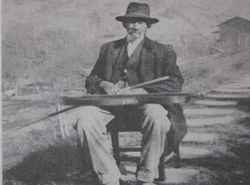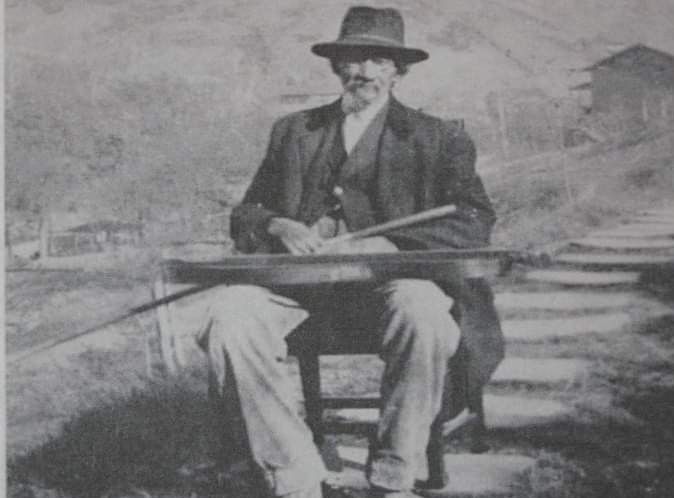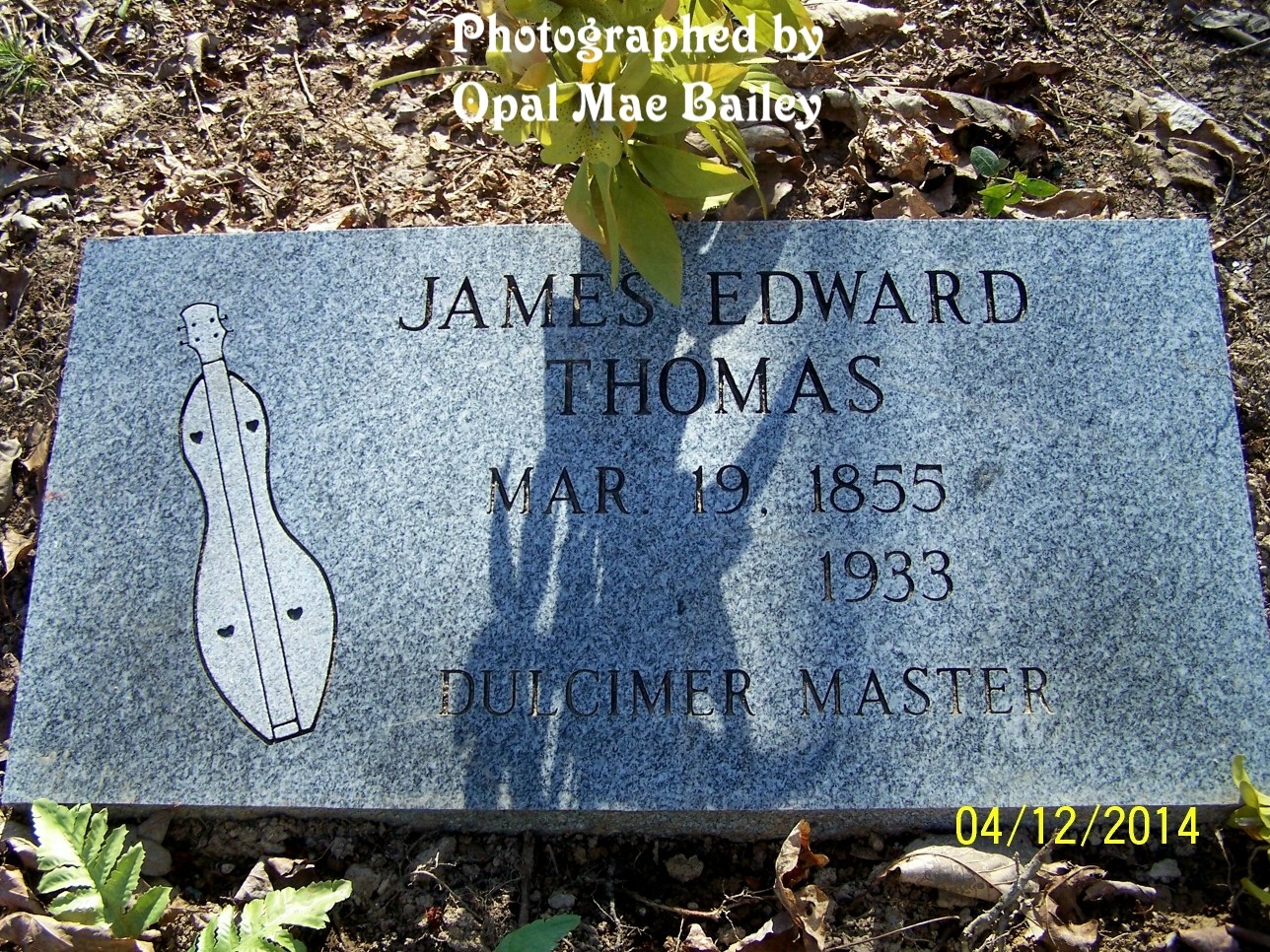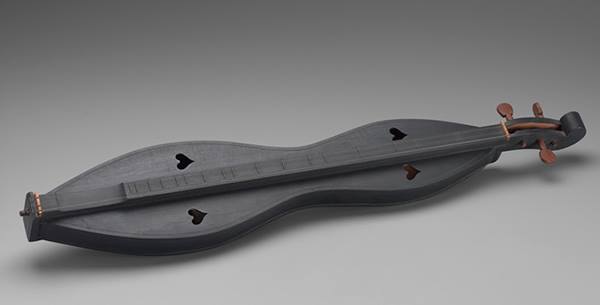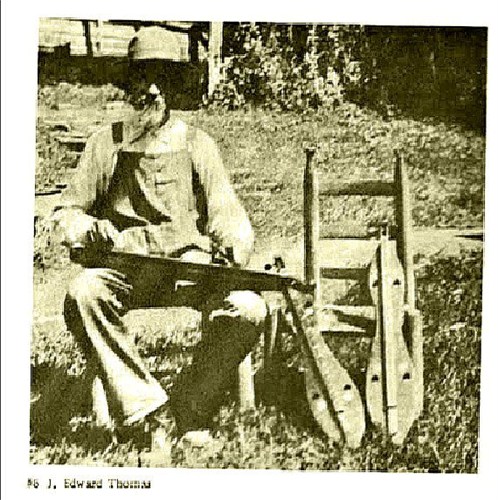known as "Uncle Ed," was born in Letcher County Kentucky
The following is an article written about him by Ralph Lee Smith and published in the Knott County History Book.
James Edward Thomas was Kentucky's great pioneer dulcimer maker. In the late 19th and early 20th Centuries, he was largely responsible for introducing the world to this beautiful folk instrument of the Appalachians.
Thomas was born in Letcher County in 1850 and died in Knott County in 1933. His father and grandfather were also named James Edward Thomas. Grandfather Thomas lived in Ashe County, North Carolina, where he married Lucy Proctor in 1805, and where he died in 1844. It is widely reported that there is Cherokee blood in the Thomas family, and it is believed that Lucy Proctor was half Cherokee (she was actually full Cherokee).
After Grandfather Thomas died, Grandmother Lucy went with her family to Kentucky in 1845. Her children included Greenberry Thomas, born about 1823, and James Edward Thomas, the dulcimer maker's father, born in 1825 or 1826.
James Edward Thomas married Mary Madden of Letcher County in 1849. Mary's ancestors came from Russell County, Virginia. James and Mary's children included James Edward Thomas, the dulcimer maker.
Thomas married Sarahbelle Nease of Letcher County. Census records disagree on her age and some other particulars. A summary of the 1870 census of Letcher County lists J.E. Thomas as being 20 years old, his wife "Sarah" as being 15, and his occupation as farmer. The 1910 Knott County census lists "Edward J. Thomas," and gives his age as 56 and his occupation as house carpenter, a change that this skilled woodworker may well have made. His wife "Sarah" is listed as age 54. The couple had ten children, of whom six were living in 1910. According to the 1910 census, Uncle Ed could read and write – a fact that we know from the handwritten labels inside his dulcimers – but Sarahbelle could not.
According to James Still, Thomas and his family lived "on Big Doubles under the Bell Conley Knob at the border between Knott and Letcher Counties." Mal Gibson, Letcher County resident who lived near Uncle Ed, says, "There's a gap a-comin' into Letcher County, and he had a log cabin our there, in this end of it."
It is reported that Thomas began to make dulcimers in 1871. Fortunately for us, he numbered and dated his instruments. The numbers show that Thomas made many dulcimers over a long period of time. He was one of the first, or the first person ever to do so. The oldest Thomas dulcimer thus far recovered is Number 469, dated January 10, 1891; the latest is number 1380, dated January 26, 1927.
No-one knows how or from whom the young farmer Ed Thomas learned to make dulcimers, or how he developed his distinctive design. Thomas' answer to the question, "How did you learn to make dulcimers?" would have shown a flood of light into this corner of Appalachian history, but there is no record that anyone ever asked him.
During the summer, Thomas traveled the dry creek beds of Knott and Letcher Counties, carrying his instruments on a little cart. He often stayed with families, who were delighted to offer him accommodations in exchange for listening to him play. The instruments cost about $5.00. According to one report, people who wanted a dulcimer but could not afford to pay cash, could buy one for 25 cents down and 25 cents a week.
In addition to being an excellent craftsperson, Thomas was a fine player. According to a neighbor, Thomas would often sit on the porch of his log cabin, playing to his heart's content.
Thomas' fame had probably spread beyond the borders of Knott and Letcher Counties before the coming of Hindman Settlement School, but the establishment of the school in 1902 was a boon for his dulcimer making.
Thomas sold dulcimers to the ladies from New York and New England who came to the school to teach, and they spread the word back home. Soon, he was receiving orders from the north. His explanation for the popularity of his dulcimers in New York was simple: "There's more people in New York than anywhere else," he said.
Although the Settlement School and out-of-state sales accounted for a large share of his business, Thomas never neglected the people of Knott and Letcher Counties, and they never ceased to buy dulcimers from him.
Thomas' legacy is large and important. The "Kentucky style" dulcimer pattern, with an hour glass-shaped body and heart-shaped soundholes, became the best-known form of the instrument during the post-World War II folk revival. Nowadays, everywhere in the world, when most people think of dulcimers, they think of the beautiful pattern that Thomas developed long ago in Knott and Letcher Counties. The newest James Edward Thomas dulcimer extant is number 1465 made in 1931.
Many dulcimer makers credit Mr. Thomas as the premier dulcimer maker of Kentucky to this day...
known as "Uncle Ed," was born in Letcher County Kentucky
The following is an article written about him by Ralph Lee Smith and published in the Knott County History Book.
James Edward Thomas was Kentucky's great pioneer dulcimer maker. In the late 19th and early 20th Centuries, he was largely responsible for introducing the world to this beautiful folk instrument of the Appalachians.
Thomas was born in Letcher County in 1850 and died in Knott County in 1933. His father and grandfather were also named James Edward Thomas. Grandfather Thomas lived in Ashe County, North Carolina, where he married Lucy Proctor in 1805, and where he died in 1844. It is widely reported that there is Cherokee blood in the Thomas family, and it is believed that Lucy Proctor was half Cherokee (she was actually full Cherokee).
After Grandfather Thomas died, Grandmother Lucy went with her family to Kentucky in 1845. Her children included Greenberry Thomas, born about 1823, and James Edward Thomas, the dulcimer maker's father, born in 1825 or 1826.
James Edward Thomas married Mary Madden of Letcher County in 1849. Mary's ancestors came from Russell County, Virginia. James and Mary's children included James Edward Thomas, the dulcimer maker.
Thomas married Sarahbelle Nease of Letcher County. Census records disagree on her age and some other particulars. A summary of the 1870 census of Letcher County lists J.E. Thomas as being 20 years old, his wife "Sarah" as being 15, and his occupation as farmer. The 1910 Knott County census lists "Edward J. Thomas," and gives his age as 56 and his occupation as house carpenter, a change that this skilled woodworker may well have made. His wife "Sarah" is listed as age 54. The couple had ten children, of whom six were living in 1910. According to the 1910 census, Uncle Ed could read and write – a fact that we know from the handwritten labels inside his dulcimers – but Sarahbelle could not.
According to James Still, Thomas and his family lived "on Big Doubles under the Bell Conley Knob at the border between Knott and Letcher Counties." Mal Gibson, Letcher County resident who lived near Uncle Ed, says, "There's a gap a-comin' into Letcher County, and he had a log cabin our there, in this end of it."
It is reported that Thomas began to make dulcimers in 1871. Fortunately for us, he numbered and dated his instruments. The numbers show that Thomas made many dulcimers over a long period of time. He was one of the first, or the first person ever to do so. The oldest Thomas dulcimer thus far recovered is Number 469, dated January 10, 1891; the latest is number 1380, dated January 26, 1927.
No-one knows how or from whom the young farmer Ed Thomas learned to make dulcimers, or how he developed his distinctive design. Thomas' answer to the question, "How did you learn to make dulcimers?" would have shown a flood of light into this corner of Appalachian history, but there is no record that anyone ever asked him.
During the summer, Thomas traveled the dry creek beds of Knott and Letcher Counties, carrying his instruments on a little cart. He often stayed with families, who were delighted to offer him accommodations in exchange for listening to him play. The instruments cost about $5.00. According to one report, people who wanted a dulcimer but could not afford to pay cash, could buy one for 25 cents down and 25 cents a week.
In addition to being an excellent craftsperson, Thomas was a fine player. According to a neighbor, Thomas would often sit on the porch of his log cabin, playing to his heart's content.
Thomas' fame had probably spread beyond the borders of Knott and Letcher Counties before the coming of Hindman Settlement School, but the establishment of the school in 1902 was a boon for his dulcimer making.
Thomas sold dulcimers to the ladies from New York and New England who came to the school to teach, and they spread the word back home. Soon, he was receiving orders from the north. His explanation for the popularity of his dulcimers in New York was simple: "There's more people in New York than anywhere else," he said.
Although the Settlement School and out-of-state sales accounted for a large share of his business, Thomas never neglected the people of Knott and Letcher Counties, and they never ceased to buy dulcimers from him.
Thomas' legacy is large and important. The "Kentucky style" dulcimer pattern, with an hour glass-shaped body and heart-shaped soundholes, became the best-known form of the instrument during the post-World War II folk revival. Nowadays, everywhere in the world, when most people think of dulcimers, they think of the beautiful pattern that Thomas developed long ago in Knott and Letcher Counties. The newest James Edward Thomas dulcimer extant is number 1465 made in 1931.
Many dulcimer makers credit Mr. Thomas as the premier dulcimer maker of Kentucky to this day...
Inscription
Dulcimer Master
Gravesite Details
An old but pretty little cemetery located atop Sunset mountain in Letcher County Kentucky
Family Members
Sponsored by Ancestry
Advertisement
Records on Ancestry
Sponsored by Ancestry
Advertisement
